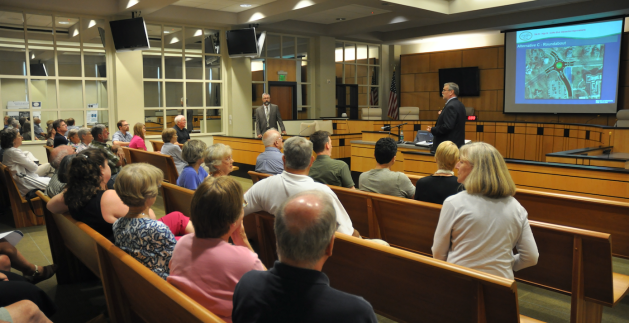Firm recommends roundabout
Published 8:21 pm Wednesday, May 31, 2017
A draft report from engineering firm McCormick Taylor recommends a roundabout be constructed at the intersection of Oak and High streets and Griffin Boulevard.
The project recommendation, which could come with a price tag of $3.8 million, came during a community meeting Wednesday in the Farmville Town Council’s chambers.
About 40 members of the the community gathered in the council’s chambers to hear the recommendation and to discuss the intersection, including many town council members and town officials.
Only one person spoke in disapproval of the construction of a roundabout at the intersection, citing pedestrian safety. Others who spoke indicated their favorability toward a roundabout.
“I think it was a great meeting,” Mayor David Whitus said following the meeting, which lasted about 30 minutes. “The public has certainly been engaged in this process, and that’s exactly what we wanted is public input, public engagement.”
“We wanted to look at the operation; that was a big key factor. How are the different alternatives going to function?” William Winston, a senior traffic engineer with McCormick Taylor, said during the meeting regarding the intersection alternatives, which include realigning the intersection or leaving it as is.
Other key factors in the study included costs, constructability and input from the February community meeting.
Winston said the firm collected pedestrian, vehicular and bicycle traffic for 12 hours on a Tuesday, Wednesday and Saturday — all separately.
Winston said the firm performed a Synchro Analysis of the alternative that called for a realignment of the intersection. “That gives us what we call a level of service,” he said, adding a Sidra Analysis — which he said was “more proprietary when it comes to roundabouts — gave the firm “a better result.”
An evaluation matrix developed by the firm included stakeholder communication, intersection operation, costs of construction and lifecycle, constructability and vehicular and pedestrian safety.
Council’s unanimous decision to contract with the Glen Allen-based engineering firm comes with a price tag of $44,000 — one that’s being split with Longwood University.
According to the matrix, a proposed roundabout ranked above a realigned intersection and no improvements based on calculated criteria of public comments in favor, level of service operation and construction cost, along with known criteria, including lifecycle cost, maintenance of traffic/constructability, vehicular safety and pedestrian safety.
Factors included in the firm’s recommendation include Virginia Department of Transportation (VDOT) policy, which details benefits regarding right of way, environmental factors, design constraints, safety, operation and lifecycle cost.
Out of the three alternatives, the roundabout ranked highest in public comments in favor, level of service/operation, construction cost, life cycle cost and vehicular safety. Intersection realignment ranked highest only for pedestrian safety.
According to the presentation, the roundabout would cost $662,083 for preliminary engineering, $2,663,636 for construction and $463,638 for right of way and utilities.
A traditional realignment, according the presentation, would cost $2.7 million, including $480,354 for preliminary engineering, $1,801,284 for construction and $416,310 for right of way and utilities.
“VDOT recognizes that roundabouts are frequently able to address the above safety and operational objectives better than other types of intersections in both urban and rural environments and on high-speed and low-speed highways,” the firm’s presentation offered, referencing a VDOT Road Design Manual.
“Therefore, it is VDOT policy that roundabouts be considered when a project includes reconstructing or constructing new intersection(s), signalized or unsignalized. The engineer shall provide an analysis of each intersection to determine if a roundabout is a feasible alternative based on site constraints, including right of way, environmental factors and other design constraints. The advantages and disadvantages of constructing a roundabout shall be documented for each intersection. When the analysis shows that a roundabout is a feasible alternative, it should be considered the department’s preferred alternative due to the proven substantial safety and operational benefits.”
“I think the roundabout is a very elegant solution to an intersection that clearly has challenges, both with vehicular and pedestrian safety,” said Louise Waller, executive director of campus planning and construction at Longwood University, which calls for a roundabout at the intersection in its Master Plan. “I’m really excited that the town and community seem to be embracing this.”
“Can we get the right of way? Yes we can,” Winston said regarding a roundabout. “The environmental factors — can they be mitigated? Yes. Design constraints — can we actually fit a roundabout in the area that we’ve got without too many impacts? Yes we can … Safety. Roundabouts just operate safer than regular intersections. They just do. And lifecycle costs. Over the long run, a roundabout will save you money.”
The next steps, he said, include receiving comments from the public on the recommendation, finalizing the report, preparing a VDOT grant application “with whatever preferred alternative we’ve decided … and then finally we’ll have a presentation to town council,” Winston said.
According to Don DeBerry, a senior traffic engineer with McCormick Taylor, “there’s revenue sharing funding sources, (which are the) most likely funding source we would apply for in this case. There’s a $10 million cap per project for any submitting agency, and it’s a 50/50 split between VDOT and the applicant,” which DeBerry said would apply to all project costs.
DeBerry estimated that construction of the roundabout would take 18 months.
“You’ll actually be able to see the pedestrians a little bit better,” Winston said, answering a question from the audience regarding pedestrian safety.
“The grant application is for either,” DeBerry said, citing that the VDOT cost sharing could apply to an intersection realignment. “But, again, you’re asking for VDOT dollars, and we’re talking about their design manual. They basically say, ‘If you’ve got a roundabout and it’s feasible, we want you to pick that.’”








